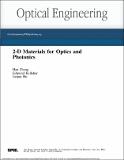Special Section Guest Editorial: 2-D Materials for Optics and Photonics
Author(s)
Zhang, Han; Kelleher, Edmund; Hu, Juejun
DownloadZhang-2016-Special Section Gues.pdf (323.8Kb)
PUBLISHER_POLICY
Publisher Policy
Article is made available in accordance with the publisher's policy and may be subject to US copyright law. Please refer to the publisher's site for terms of use.
Terms of use
Metadata
Show full item recordAbstract
Throughout the last decade, interest has grown significantly in the photonic applications of 2-D materials since the emergence of graphene. The unique optical and electronic properties of graphene, including broadband absorption, high electron mobility, and ultrafast carrier dynamics, qualify graphene as a next-generation platform for advanced optoelectronic devices. In addition to semimetallic graphene, topological insulators, semiconducting transition metal dichalcogenides, and insulating hexagonal boron nitride have emerged, offering similarly fascinating, yet distinct, optical properties. Recently, 2-D layered black phosphorus (BP) has been found to interact strongly with light, while possessing a layer-dependent direct bandgap, adding to the catalog of 2-D crystalline materials with highly tunable properties suitable for photonic applications. The breadth of available 2-D materials, including wide-bandgap insulators, narrow-bandgap semiconductors, metals, semimetals, and topological insulators, supports operation covering a wide range of frequencies from the visible to the microwave region. As such, 2-D materials have enabled revolutionary breakthroughs in optical sciences, and represent a new paradigm for the development of advanced optical devices. Intense research progress in the field in a relatively short period of time has necessitated this special section on 2-D materials for optics and photonics that aims to summarize recent research in this area, while highlighting cutting-edge results.
This special section presents 18 papers by internationally recognized research teams, addressing a wide range of recent advances in photonic technologies based on 2-D materials. A significant number of the papers in this special section are devoted to investigating the light-matter interaction in 2-D materials and its applications for nonlinear optics, ultrafast phenomena, particularly in femtosecond pulse generation.
Date issued
2016-08Department
Massachusetts Institute of Technology. Department of Materials Science and EngineeringJournal
Optical Engineering
Publisher
SPIE
Citation
Zhang, Han, Edmund Kelleher, and Juejun Hu. “Special Section Guest Editorial: 2-D Materials for Optics and Photonics.” Opt. Eng 55, no. 8 (May 17, 2016): 081301.
Version: Final published version
ISSN
0091-3286